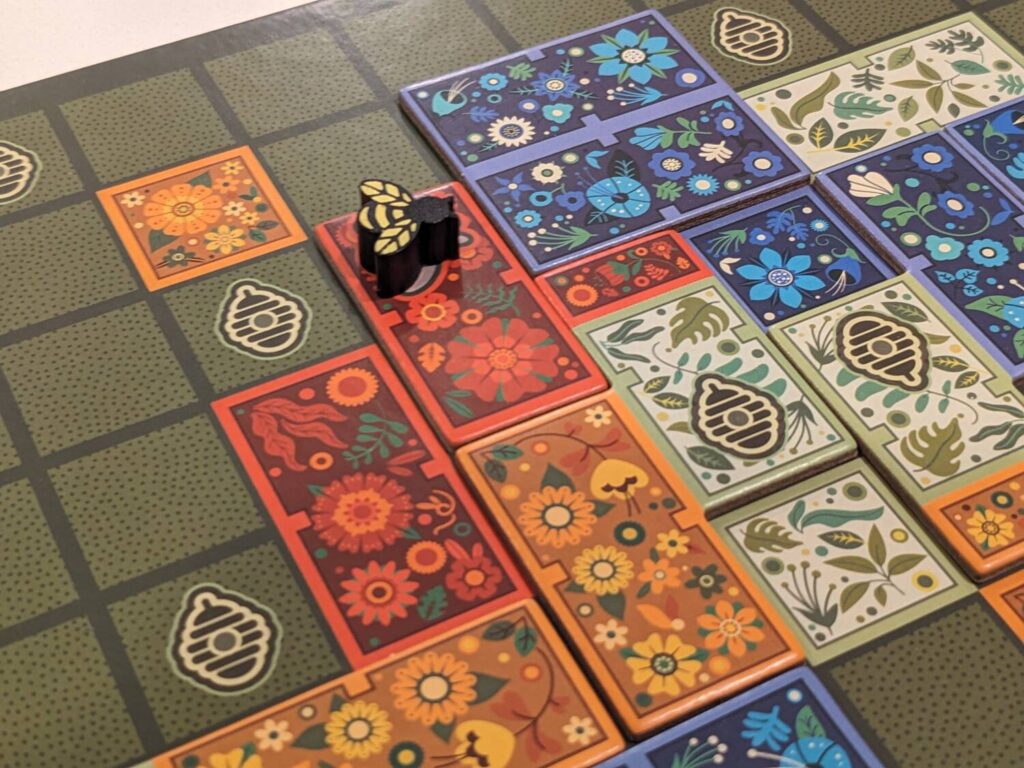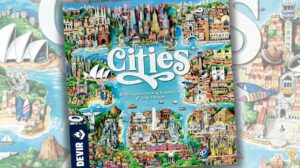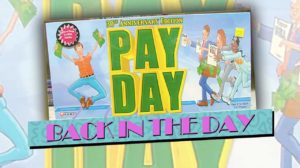Disclosure: Meeple Mountain received a free copy of this product in exchange for an honest, unbiased review. This review is not intended to be an endorsement.
Each time I have the chance to pick up a game from our partners at Horrible Guild, I get excited. The Italian publisher has given us countless hits over the years: Railroad Ink, Evergreen, Quicksand, The Great Split, and Dungeon Fighter, to name just a few. It’s a testament to their team that in a world where I gift most of my review copies to other players in my network, I still have three of the games listed above in my collection.
During our visit with the Horrible Guild team at SPIEL 2024, I picked up a review copy of Flower Fields, designed by Luca Bellini and Luca Borsa. Flower Fields is a simple tile-laying game that I played three times over three days—once each at different player counts: solo, two players, and three players. Using a mechanic familiar in many other games, players have a small board to hold tiles in a variety of colors, and must select new tiles from a market to place into their tableau to score points at the end of the game.
Flower Fields doesn’t do anything fancy. My eight-year-old son had the game down by the second round of our first game. It’s a little too easy for my tastes—I scored 103 points in my solo game, earning the highest tier of accolades on the list of “score attack” tiers for this accomplishment, and I didn’t feel challenged to reach that point threshold, which means I’ve already solved the game’s riddle after just a few plays.
But as a family-weight game, my kids enjoyed Flower Fields and the playtime was a breeze. That means this is worth a look for game night over the holidays with extended family, or as a game you can show to those “muggle” friends of yours and still have an enjoyable time.

BEEEEEEES!
Flower Fields is a 1-4 player tile placement game. My three games each wrapped in under 30 minutes. The goal here is to build an attractive flower garden, per the description on the box. On a turn, players have four action choices:
- Take a small flower tile from a central market, paying its cost in bees (yes, bees!) to the supply. And, if there’s a bee space on that tile, dropping a bee from their personal stash there to boost its end-game scoring.
- Take a large flower tile adjacent to the outer market’s next tile in line, paying nothing. Players could instead take a different tile in a ring of other choices, but each tile skipped must be paid for with a bee. Other games, such as Pax Pamir 2E, use a similar mechanic—skipping other options in a line of market cards is fine, as long as you leave in-game currency on the table for future players to take when they select those other tiles. Once this flower tile is placed, a player can place a bee on this new tile, similar to the action above.
- Take two bees from the supply, to fund future actions.
- Place one bee from the player’s personal stash onto a bee space on a flower tile, if they were not able to do this when the tile was first placed.
And that’s it. Turns are quick, and like games such as Patchwork, you’ll always be shopping for the perfect tile that can help solidify a big end-game point total. Scoring is tied to a mix of earning points for the highest-scoring color section in your final grid layout (there are four different colors featured in the game, so this accounts for four distinct scoring categories) and earning a flat five points per completed row or column on your player mat.

Know Your Role
Flower Fields was a delight to play with my family, and while I had a leg up on the opponents I took on for my review plays (I play a lot of these types of games, but my kids do not), the kids still seemed to have a good time.
But in a sign that Flower Fields might not have a long shelf life here at the Bell compound, neither my 10-year-old nor my eight-year-old asked to play the game a second time. (I promised my eight-year-old additional tablet time if he would play Flower Fields twice, so this attempt at a bribe worked out.) And this is not the kind of puzzle I would expect solo gamers to embrace long-term because of the sheer lack of variety in the box here. I played it once solo to feel out the system, and this is a very easy solo bot to administer. It just wasn’t that interesting and the bot never takes tiles more than two spaces away from the market token’s location, so it becomes easy to predict which tiles are safe for the player to build.

Flower Fields has a puzzle that seems straightforward—maximize the number of completed rows and columns, since that ended up being my biggest scoring category when I achieved the 100-point threshold. Of the four tile colors, white is the weakest, and bees cannot be added to white sections of a player’s scoring area. So focusing on building out large sections of blue, orange and red tiles always took priority.
Taking that approach when adding polyomino shapes to a player’s board makes shopping a snap. I think experienced players will see through that part of the design quickly, and playing against similarly-skilled opponents will make Flower Fields more interesting.
If tile-laying games are your thing, give Flower Fields a look. It doesn’t have the legs for 10+ plays, but it was a fun time at the table for a half-hour with the kids.












Add Comment